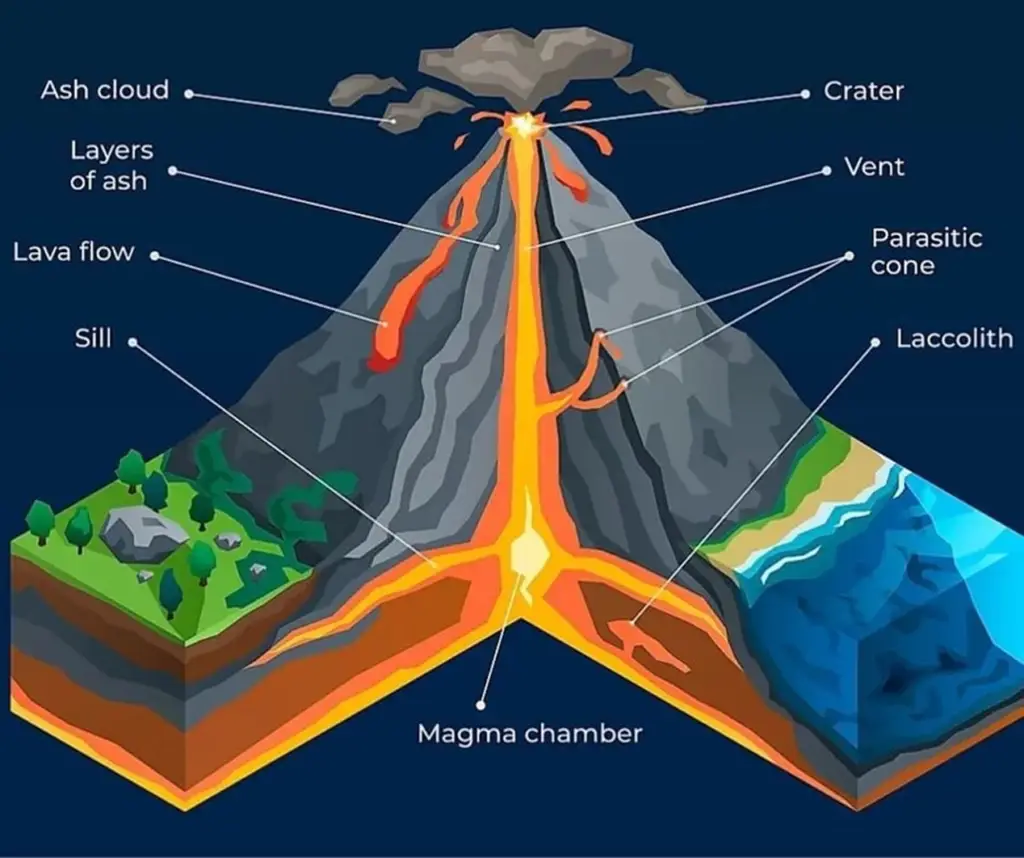This blog provides information about Volcanoes. First, it discusses that what are volcanoes and the types of volcanic eruptions. Then we will study about anatomy and formation of Volcano. Second, we will discuss the classification and types of volcanoes. At the end, we will discuss the Environmental Impacts of Volcanoes in detail. This blog contains eruptions, anatomy, formation, types and environmental impacts of Volcanoes.
What are Volcanoes?
Volcanoes are the openings or vents where lava, tephra (small rocks) and steam erupt onto the Earth’s surface. These are basically the path for magma and lava to come on the surface of the earth.
Volcanoes erupts with gases and add them in the atmospheric gases. In this way they have many different impacts on the environment. After the eruption the ashes that are made provide a cooling effect on the earth because the ashes after fire are always cold and make us feel cool.
Volcanic eruptions are an amazing natural phenomenon. It leave us stunned and amazed. Volcanic eruptions can last days, months or years.
Types of Volcanic Eruptions:
The volcanic eruption is the state when an active volcano eject lava, ash, magma and gases. The word erupt means to force out or release drastically. These eruptions can be of two types. These are as follows:
1.Effusive Eruption:
It is a quite form of eruption. In this type, the lava flows steadily into the surface of earth and there is no explosion. It run out instantly without any caution, sound or explosion. This basically effect the Earth surface through magma.
2.Explosive Eruption:
The eruption through a loud explosion is called as explosive eruption. Explosive eruption is with a loud explosion, sending the gases directly into the atmosphere because this eruption first go in upwards direction in a drastic form and then comes to the Earth’s surface.
Anatomy of Volcano:
As you read in, when magma reaches Earth’s surface it is called lava. Lava reaches the sur- face by traveling through a tubelike structure called a conduit, and emerges through an opening called a vent. As lava flows through the vent and out onto the surface, it cools and solidifies around the vent. Over time, layers of solidified lava can accumulate to form a mountain known as a volcano. At the top of a volcano, around the vent, is a bowl-shaped depression called a crater so the crater is connected to the magma chamber by the conduit. Locate the crater, conduit, and vent of the volcano.
Volcanic craters are usually less than 1 km in diameter. Larger depressions, called calderas, can be up to 50 km in diameter. Calderas often form after the magma chamber beneath a volcano empties from a major eruption. The summit or the side of a volcano Analysis collapses into the emptied magma chamber, leaving an expansive, circular depression. After the surface material collapses, water sometimes fills the caldera, forming scenic lakes. The caldera known as Crater Lake in southern Oregon formed when Mount Mazama collapsed. This blog contains eruptions, types and anatomy of Volcanoes.
Formation of Volcanoes:
A volcano mountain is formed by the surface eruption of magma from within the earth’s upper mantle. The magma that erupts to the surface and forms a lava flow that deposits ash so as the volcano continues to erupt, a new layer of lava is added to the surface, accumulating to form a mountain.

Classification of Volcanoes:
Following are basic classifications of volcanoes:
Active Volcanoes:
The volcanoes who have a recent history of eruption, we can call them Active volcanoes so this depicts that the considered volcano had its activity in near past. That is why we call it as Active volcano.
Dormant Volcanoes:
Dormant volcanoes are those which are quiet at the moment, but can erupt anytime in the future and the time cannot be predicted. These are silent volcanoes that erupt without warning.
Extinct Volcanoes:
Extinct volcanoes are those that are considered non-erupting volcanoes by the scientists and are declared not being able to erupt again in future. These are dead volcanoes.
These are the main classifications of Volcanoes.
Types of Volcanoes:
The appearance of a volcano depends on two factors: the type of material that forms the volcano and the type of eruptions that occur. Based on these two criteria, three major types of volcanoes have been identified. Each differs in size, shape, and composition.
Shield volcanoes:
A shield volcano is a mountain with broad, gently sloping sides and a nearly circular base. Shield volcanoes form when layers of lava accumulate during nonexplosive eruptions. They are the largest type of volcano. Mauna Loa is a shield volcano.
Cinder cones:
When eruptions eject small pieces of magma into the air, cinder cones form as this material, called tephra, falls back to Earth and piles up around the vent. Cinder cones have steep sides and are generally small; most are less than 500 m high. The Lassen Volcanic Park cinder cone is 700 m high. Cinder cones often form on or very near larger volcanoes.
Composite volcanoes:
These volcanoes are of layers of hardened chunks of lava from violent eruptions alternating with layers of lava that oozed downslope before solidifying. Composite volcanoes generally have cone-shape with concave slopes, and are much larger than cinder cones. Because of their explosive nature, they are potentially dangerous to humans and the environment. Some examples of these are Mount Augustine in Alaska, and several in the Cascade Range of the western United States, such as Mount St. Helens.
Lava Volcanoes:
Lava volcanoes are the fourth sort of spring of gushing lava that we will examine. Dissimilar to composite and safeguard volcanoes, magma arches are of little height. They frame when the magma is too gooey to even consider streaming to a huge span. As the magma vault gradually develops, the external surface cools and solidifies as the magma keeps on heaping inside so ultimately, the inner tension can break the external surface, making free parts spill down its sides. For the most part, such magma arches are on the flanks of bigger composite volcanoes.
All these types have different shapes, sizes, eruptions and appearances. This blog contains Anatomy and Types of Volcanoes and Volcanic Eruptions.

Environmental Impacts of Volcanoes:
Following are the environmental impacts of Volcanoes:
• Hazardous Volcanic Gases:
The gases emitted into the atmosphere at the time of volcanic eruptions are sulfur dioxide, carbon dioxide and hydrogen fluoride so these are extremely hazardous gases for life on earth.
• Deterioration of Water Quality:
Volcanoes are the cause of water pollution in the nearby areas so it adds ashes, gases and increase the temperature of water by destroying its quality and making it non-drinkable.
• Less Rainfall:
In the areas of volcanoes, there is less rainfall. In this way plants and crops do not get enough water for growth and development and it disturbs the vegetation of that specific area.
• Harmful for Health:
Hazardous gases from volcanic eruptions lead to many serious respiratory disorders into humans and plants so it is really hard on the people that are present in nearby areas.
• Global Cooling:
Aside from all the negative impacts, volcanoes also produce cooling effect on the earth by the ashes that are left behind. Because we can see that ashes are always cooler so in last few years in the areas with volcanic eruption, we observe that the temperature dropped after eruption.
This blog contains anatomy, eruptions, Types of Volcanoes.
To learn about more topics, Click the links below:


Comments